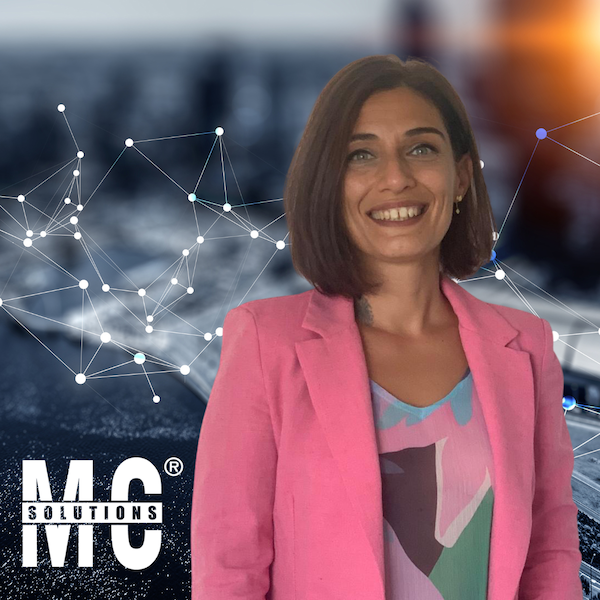Good morning Vincent and thank you for hosting me in your podcast. As you said, I'm charge of export and marketing and so I take care both of communicating our innovative solutions to the aviation community and bringing MC Solutions on the international market. The mastery of MC Solutions is data transmission. We manufacture engineer and manufacture tailored hardware and software solutions and in the airport field we deliver the remote monitoring and control of airfield, ground lighting and auxiliary services.
One of the thing I like a lot about MC Solutions is that you have a very strong family background. Can you tell us a bit more about the company history please?
Yes, with pleasure. The company was funded around the nineties with my father. We are very proud of him. The patent was born with his ideas, innovative ideas and in 2016 my brother Maurizio took over the company and in 2019 we have completed the installation of Venice Airport CAT III B airport. So Maurizio called me and asked me to jump on board and bring the company well known all over the world. So that's my commitment.
That's really nice to see a family history going with that kind of success. You mentioned the patternts and the ideas of your father and one of the major design difference is that you use optical fibers intensively in your solution. Can you explain us what are the design factor behind that decision to use your optical fibers?
Yes, we have faced on field all the issues of power line communication technology. All the design and engineering ideas came from the experience on field. The use of optical fiber is on the airfield. That is the innovation that grants to the airport the reliability of the communication, the immunity to interferences, the real time communication. You can just think about watching a movie on demand at your home. Of course everyone can understand the advantages. So you have huge amount of data you have no interferences and the communication is very fast and this is extremely important in term of safety. If you think about controlling stop lights real time communication is an essential feature.
Yeah, that's true. And I think not a lot of people realize how slow some classical airport ground lighting systems can be. Just to make the scope a bit more clear, you offer the control system, you offer A-SMGCS, you have some safety net features but you are not offering the lamps and the fixtures themselves. Is that correct?
Exactly, because we firmly believe in the independence of the airport and the freedom of the airport to decide to combine multiple suppliers. So we are compatible with any kind of airfield ground light with any kind of CCRs unit. The airport is free to choose their suppliers also in a multiple solution. For example, at Venice airport we have interfaced two manufacturers for CCR units and of course we have developed our architecture to be compatible to the infrastructure that we find also because if you think about from a budget perspective of course the up upgrading and updating of the electrical votes and CCR unions are a long many years. And so it is quite natural finding already a combined solution and multiple suppliers at the same airport.
That's really nice to see how you can integrate with others. I just want to play devil's advocate a bit here. One of the issues probably or one of the challenges with optical fibers is that you need to have them installed. If you build a new airport from scratch, you will obviously put fiber everywhere along your power lines and then you have that nice separation. But how expensive or how complex is it to integrate or retrofit an optical fiber control solution in your AGL at an already existing airport? Because does that mean you have to dig everywhere and lay fiber down?
Actually it is a misunderstanding that is quite commonly spread. I mean laying down optical fiber is well of course it is easier if the infrastructure is new, the project is new and you have to prepare the dots. So of course it is better and easier. But anyway, it is not impossible in an already existing infrastructure because optical fiber cables, so they do not have a metal armor so they are not arm with metal shield. So we can lay them down together with the power supply. So it is not difficult as someone can imagine. Moreover we can optimize the number of transformers and the numbers of models into the manuals so we can optimize the space of the pit, which is always an issue in the infrastructure, in the airfield infrastructure.
Yeah, it looks like you are bringing a lot of innovation and advantages with your solutions. What kind of feedback do you get from airports where your solution is used? You mentioned Venice a couple of time, I guess there are a few others as well. How do they react and why did they choose you and how happy are they with your solution and your innovation?
Let's say that, yes, of course we have other airports mainly in Italy at the moment. This is the goal of my presence here at MC Solutions to expand and get more airports abroad. So a part of the 11 airports that we have in Italy Venice is the most complete example of our architecture. So that's why I always mentioned this example. We have three years of survey available now and the main reason of their satisfaction is low maintenance intervention. And if you can think about the last two years reducing and containing the fixed maintenance cost is a quite important point for airports when incomes are getting narrow. So it is very, very important at this aspect about reducing maintenance fixed cost. So we have had in three years no failures on optical connectors, zero failure on 3,400 optical connectors that we have installed. We have add zero failure on optical fiber segments and we have add just the 2% of spare parts for our monitoring models always in three years on 1,725 monitoring models.
So the results about maintenance is maintenance fixed cost are very astonishing and on the other hand they are very, very happy about the performance of the system. We can interrogate all the ground lines that are around 4,000 and receive the feedback from them in 0.7 seconds. So the responsiveness and the reaction of the ALCMS is very impressive. In addition to this we can say that especially in this moment when we are facing a sort of chaos in managing the passengers flow, I think a very efficient system is becoming a very important aspect. Beside safety it is a very important point thinking about the airport total management fluidity.
That's quite impressive for you can reduce the maintenance cost with your new solutions. And I was also impressed in the preparation by the figures you named with very detailed accuracy on the reaction time and things like that. And actually your company also offers independent measurement tools to measure the performance reaction time of an ALCMS. Can you tell us a bit more about the tools you offer and about also the importance to adhere to standards but not only adhere to the standard but also demonstrate compliance towards them?
Yes, in fact, this number that I mentioned have been detected by LTC which is the lamp time control. It is a measurement instrument as you have introduced to our audience that was born to measure the efficiency of our system. Then actually we realized that it was important for the airport managers, for the airport operations managers to have a concrete and tangible measurement of the responsiveness of their remote control system. And so we have engineered this instrument that again is completely compatible with any kind of ALCMS. We use Yagi antenna and we connect this instrument with the standard FAA connectors to the lamps on field and we have an acoustic alarm that automatically stops when we receive the communication of burnt lamp from the field and flow the antenna. This is of course with a 0.7 seconds, it is impossible to use a traditional stopwatch to measure the time. There are too many factors that, for example, the human reactivity, the responsiveness of our time and eye to stop a watch to measure. So a little lapse of time.
That's really nice to see how you can really control the reaction time of an ALCMS. But did I understand correctly this is not only for your systems but you could basically go to any airport and kind of run an audit and measure the reaction time whatever the supplier of the lamps and the control system is?
Exactly. We realized at the second stage that these instruments can be helpful and support the airports and not just being an instrument to measure our product and the reliability of our architecture for monitoring the control. So we have already experienced some tests in its some Italian airports and this is done with the aim of giving an analysis to the AGL infrastructure managers and to test exactly and understand where is the circuit that can be improved and which are the problem that they are facing. If you can think about stop bar management it is a very critical issue, a very critical area of the airfield and it is very important to have a tangible and let's say a scientific calculation.
Yeah, that sounds really interesting and I guess some airports and AGL people listening to that could be interested. So by the way, if that's your case, you will find Deborah's contact and mc solution contact in the of notes. But now Deborah, I'd like to look a bit beyond ATM and other activities of your company because as you mentioned, mc solution is active in many fields ATM and non ATM, and I wanted to ask you if you have examples of ideas or technology transfer where your experience outside of ATM helped your ATM activities or vice versa where some ATM knowledge you gained helped you with other non ATM activities or non ATM products you offer?
Yes, through the years we have experienced how we have to interact mainly at control tower to interact with other companies and we have developed our software so that we can share our, the data collected on field to the air traffic management. We are invoked in the air traffic as you said with the A-SMGCS. So we move aircrafts on ground, but we have to be aware of the fact that our system is used at control tower where the controllers have lots of softwares, very high tech software and they have to rely to an infrastructure that most of the time is very, it is not at the same level of efficiency as they need to manage aircrafts both on the air and in the ground. We can say that we are facing a misalignment in the high tech and in the upgrade because of course it is very committing, upgrading the infrastructure on airfield and it is let's say quite accessible upgrading the software used at control tower.
So we are facing a misalignment in the upgrading of these two parts, the upgrading of technology delivered, so the end users that are the controllers, they have to rely to infrastructure without let's say having the direct control of the infrastructure upgrading. So we have developed with our software specialists a system that can be simply integrated by sharing a database. It is very easy and we think that this is the kind of fair engineering as a fair business. We have to keep on going in the future in order to interact as much as we can and create synergies from airfield together with airfield and tower, air traffic and management and the ground support. It seems now that at airports these are all separated planets of the same universe. Instead, I personally believe that we shall act as a unique planet and universe with the same goal of making land and take off safely all our flights.
That's really nice to see how you come with openness and are ready to integrate because in that industry we've seen for too much time companies trying to be capturing the customers and keeping them locked in. So it's really nice for me to see someone coming and say, Hey, we are open, we do interfaces, we are ready to share our data and that's really nice. Now to wrap up, I'd like to ask you our typical question. What do you see as being the future and the evolution of airfield lighting and A-MGCS in the next five years, but also in the next 50 years to open the door to bit more fantasies?
This is the last question, but I think the most difficult one. I think that in the next five years, but we are already facing the reaction after covid. We are already facing an increase in passenger traffic that compulsory need high technology and high efficiency not just with soft term but also with hardware installed on field. And I'm happy you appreciate our compatibility vision and I hope that the audience will appreciate that as well. This is the attitude that all the big companies shall have in my opinion, for the future. Also thinking about sustainability because we are focusing on this aspect mainly in the last two years, and I think that to obtain this goal as well as efficiency as well as this move flights for our passengers we are understand how to cooperate and to get synergy and to get the best from the single professionality, the single companies interacting in the same world.
And now to push the boundary a bit further down the time scale, how do you see AGL and traffic management on the ground in 50 years from now?
For sure, optical fiber on field will be the answer to solve lots of issue that we are already facing now such as interferences the need to cope with extremely high frequency flight and the increase of light demand. The regional hubs will increase in number in order to offer a best experience, a better and the best experience for our passengers. So this use of optical fiber on the ground will give the solutions to many, many problems that we are already facing now.
Debora, thank you very much for being our guest today and for sharing your view and ideas and enthusiasm. And for everybody who wants to learn more, you can check mc solutions on the www.mc-solutions.it and you will find all the details on the episode notes. Thank you and talk soon.
Thank you Vincent. Thank you all. Thank you for inviting me.




